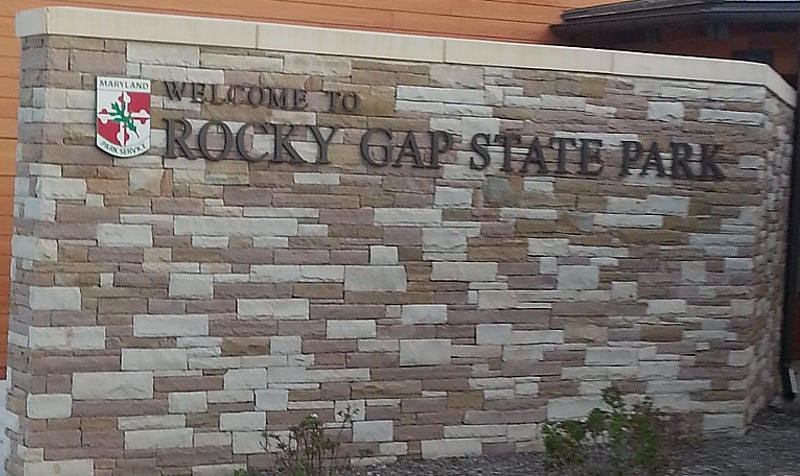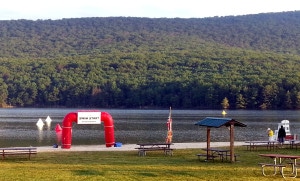Triathlon Across the USA: State #15 – Maryland

Flintstone, Maryland; June 1, 2013—Rocky Gap Triathlon, Rocky Gap State Park.
Our Maryland triathlon took us to the northwest corner of Maryland, about two miles south of the border with Pennsylvania. We had been to the urban areas of eastern Maryland before. However, this part of Maryland, in which rugged tree-covered mountains seemed to wrap their arms around us, was like another state.
Traveling to the Maryland Triathlon
We left our house in Chicopee, Massachusetts, on Friday morning, heading in a southwesterly direction. The approximately 450-mile drive took us through Connecticut and past New York City. Once in Pennsylvania, we traveled through Allentown and Harrisburg, making a stop in chocolate themed Hershey.
Before driving to our hotel in Cumberland, Maryland, we stopped at Rocky Gap State Park in Western Maryland’s Allegany County. During the brief visit, I checked out portions of the swim, bike, and run courses.
We then headed to the Cumberland YMCA to pickup the race packet. While managed by Tri Columbia, this triathlon doubled as a fundraiser for the Cumberland YMCA.
After dinner at Henny’s Bar & Grill near our hotel, we turned in for the night, ready for a pre-dawn departure to compete in the Maryland triathlon.
26th Annual Rocky Gap Triathlon
The sun shone brightly as participants of the sprint and International distance triathlons gathered at the park.
Distances for the individual legs of this USAT-sanctioned sprint triathlon were slightly shorter than normal:
- Swim: 0.25 mile (400 m)
- Bike: 8 mile (12.9 km)
- Run: 2.5 mile (4 km)
Swim
The swim portion of the race took place in 243-acre Lake Habeeb. The lake lies in the shadow of Evitt’s Mountain, named for one of the first European settlers in Allegany County.
The water temperature was around 72° F, making the race ‘wetsuit legal’. Swimmers started in four waves (groups), with the sprint men being in the first wave.
The sprint course was triangular shaped. From the beach, we swam diagonally toward an orange buoy. After turning at this buoy, we returned to shore, swimming perpendicular to the beach.

Bike
The bike course left the park through a quick ride up a short, gradual hill that exits the park. At the first intersection, the course turned left and followed the rolling Pleasant Valley Road with a gradual rise of 150 feet (45 meters) over the 4-mile distance to the halfway mark of the course.
At the half-way point, we turned around to return to the transition area with the ride in this direction being mostly downhill.
Run
The 2.5-mile, out-and-back run course began by passing the Rocky Gap Casino Resort on Old Hancock Road Northeast. At a little over a halfway into the ‘out’ portion of the run, we turned right onto Lakeside Loop Trail/Gorge Road Northeast heading toward Rocky Gap Dam.
Reaching the dam meant that we had nearly reached the turnaround point, which was a little over halfway across the dam. From here, it was back to the Finish Line along the same route. The only difference was that during the last few hundred yards (meters), we sprinted on a grassy path.
During the last mile, it surprised me to watch as a man with a 70-something number written on his right calf passed me. (For those of you who have taken part in a few triathlons, chances are that in at least one of those, you will have had your age marked on one of your calves.)
Learning From the More Experienced, No Matter Their Age
I am not comfortable striking up a conversation with a stranger. However, I have found it easier to start a discussion with a fellow triathlete. The shared interest in the sport and our mutual desire to see others succeed at it, especially at the amateur level, is clear.
During the cool-down after the race, I met the 70-something man who had passed me on the run, James Chapman. Being both impressed by his overall ability and curious to learn how to improve my running ability, I struck up a conversation with Jim about his training program. More specifically, I asked him how I should train to run faster.
During the conversation, Jim also shared information about his fueling approach. I recorded his comments about fueling in What I Learned About Race Fueling at the Rocky Gap Triathlon.
Triathlon run training for faster seniors
Jim summarized his run training program as follows:
- Start with a couple of months of 3 to 5 mile easy runs three times per week. This will build a base level of fitness.
- After the initial phase, introduce hill repeats. Hill repeats are done after a 20-minute warm-up run. Start with 3-5 repeats of 10-20 seconds running up a moderately (5-10% grade) steep hill during one of the weekly runs. Over several weeks, gradually (to avoid injury) increase the duration to 1 minute. End the session with an easy one mile cool down run.
- NOTE: Hill repeats can be done on a treadmill since you can precisely control the grade and pace.
- A third key to faster running is intervals. Jim’s coach had him “doing 30 second to 3 minute pickups where you gradually run at race pace (not as fast as you can go – that leads to injury).” Jim said “My favorite interval session is a one mile repeat where I run one mile at race pace and then either jog or walk for 2 minutes and then do two more repeats. After the last repeat, run an easy one mile to cool down.”
For Jim, there are two other components of an effective run training program:
Stretching: For Jim, it is critical to stretch the Achilles tendon and calves after every workout, including after swimming. I can echo the importance of stretching after every workout, whether swim, bike, or run.
Related post: Optimal Stretching Pre and Post Workout
Strength training: Jim’s major exercises for strengthening the legs and hips are (1) step ups, (2) body squats, and (3) one leg squats.
Related post: Review of Mark Allen’s Strength Training for Triathletes
After the Maryland Triathlon
Since I was racing the next day in the Independence Triathlon in Pennsylvania, Joy and I started our northeasterly journey toward Quakertown – after a shower and change of clothes, in the park facilities.
Race Firsts
- First triathlon during which a portion of the run course was on a dam.
- This was the first time I sat down for a long conversation with a fellow triathlete after the race.
Have You Done a Triathlon in Maryland?
Tell us about the race or races you have done in Maryland.
What have you learned from other triathletes during or after a race?
Comments: Please note that I review all comments before they are posted. You will be notified by email when your comment is approved. Even if you do not submit a comment, you may subscribe to be notified when a comment is published.
